Briefing on Arctic and Antarctic sea ice - June 2025
Alex West and Ed Blockley
Summary
- Arctic sea ice extent is currently well below average, the 5th lowest on record for the time of year following quite fast ice loss during May
- Extent is particularly low in the seas on the Atlantic side of the Arctic
- Winter and spring in the Arctic have been very mild, and winter Arctic sea ice extent has been very low, recording the lowest maximum extent in the satellite record
- Antarctic sea ice extent is very low, the 3rd lowest on record for the time of year
- The low anomaly is not evenly spread, with three regions of very low extent alternating with three regions of near-average extent, coinciding with the prevailing winds during late spring
Arctic
Sea ice state
Arctic sea ice extent on 8th June 2025 was 11.37 million sq km according to the OSI SAF Sea Ice Index (Lavergne et al., 2023). This was 0.87 million sq km below the 1981-2010 average. It was the 5th lowest extent for the time of year in the satellite record (since 1979), with the lowest having been 11.07 million sq km in 2016 (Figure 1).
Extent was well below average across most of the Atlantic Ocean side of the Arctic, as well as in Hudson Bay and Baffin Bay. It was also below average in the Laptev Sea north of Siberia, where melting had commenced earlier than average. However, extent was near-average across the Pacific side of the Arctic, as well as in the Greenland Sea (Figure 2).
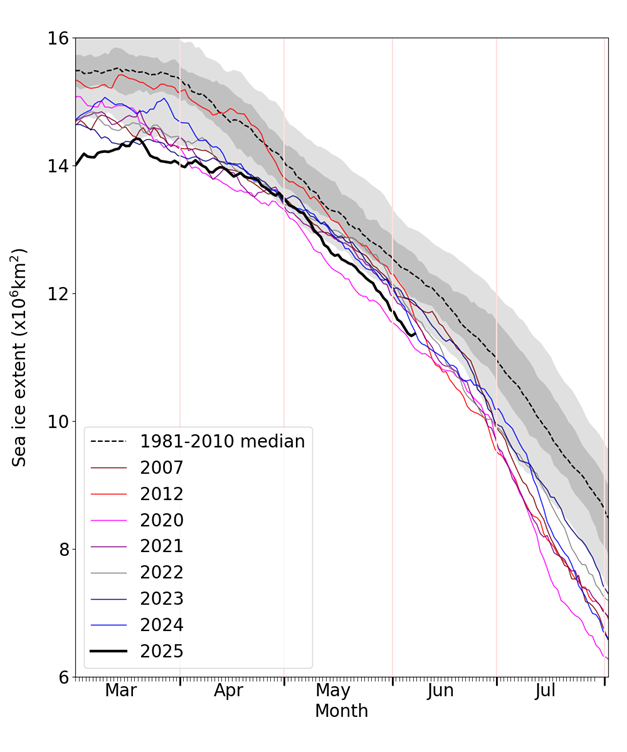
Figure 1. Daily Arctic sea ice extent for 2025, compared with recent years and the 1981-2010 average with interquartile and interdecile ranges shown by the shaded areas. Data are from the OSI SAF Sea Ice Index (Lavergne et al., 2023).
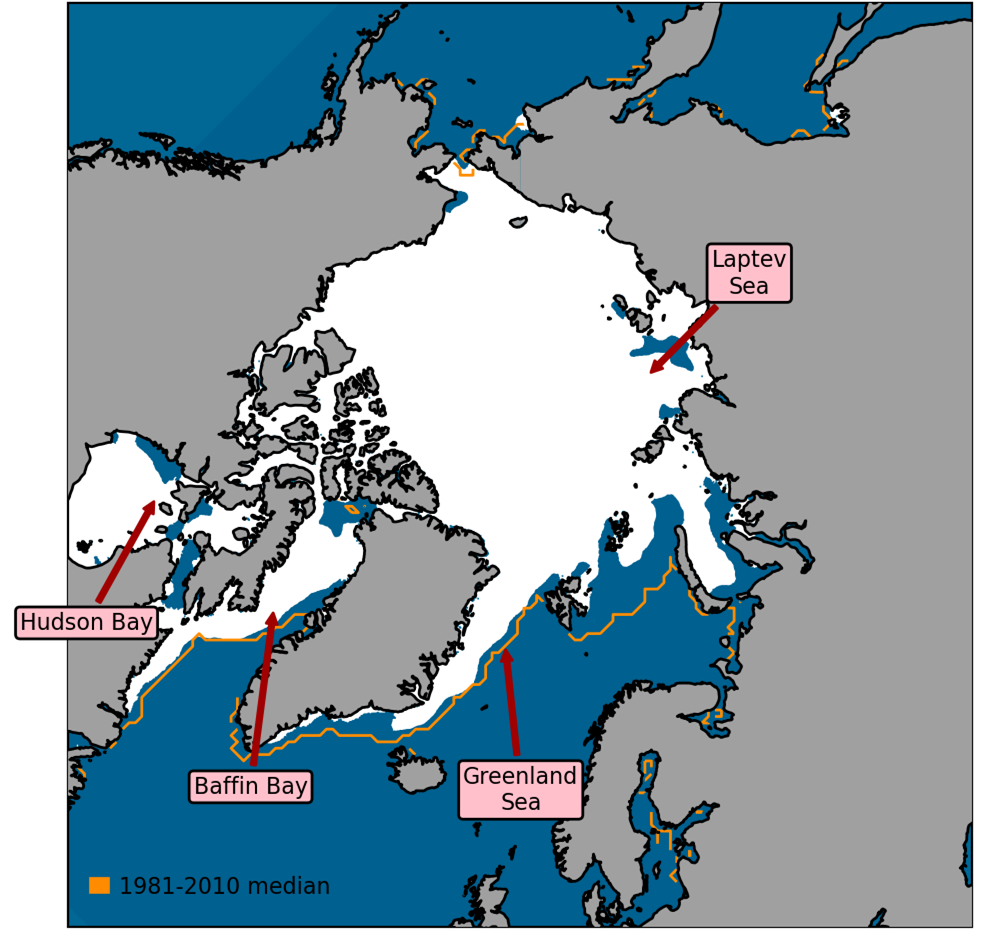
Figure 2. Arctic sea ice extent on 8th June 2025, with 1981-2010 average extent indicated in orange, and the regions referred to in the text labelled. Data are from EUMETSAT OSI SAF (Tonboe et al., 2017).
Winter and spring review
The winter of 2024-25 was very mild in the Arctic. As measured by average temperatures at the 925hPa level (about 1km high in the atmosphere) north of 70°N, averaged from November-March, it was the joint-mildest winter on record, effectively equal with the winters of 2016-17 and 2018-19 at around 3°C above the 1981-2010 average (Figure 3). While mild temperatures were spread roughly evenly across the Arctic over the season as a whole (Figure 4a), December was particularly mild in the Siberian seas, and February in the Central Arctic.
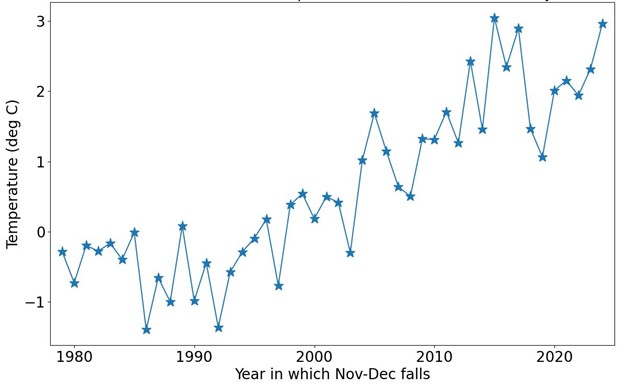
Figure 3. Average temperature anomaly at 925hPa above 70°N from November-March, according to the ERA5 reanalysis (Hersbach et al., 2017). Anomaly is relative to the 1981-2010 average.
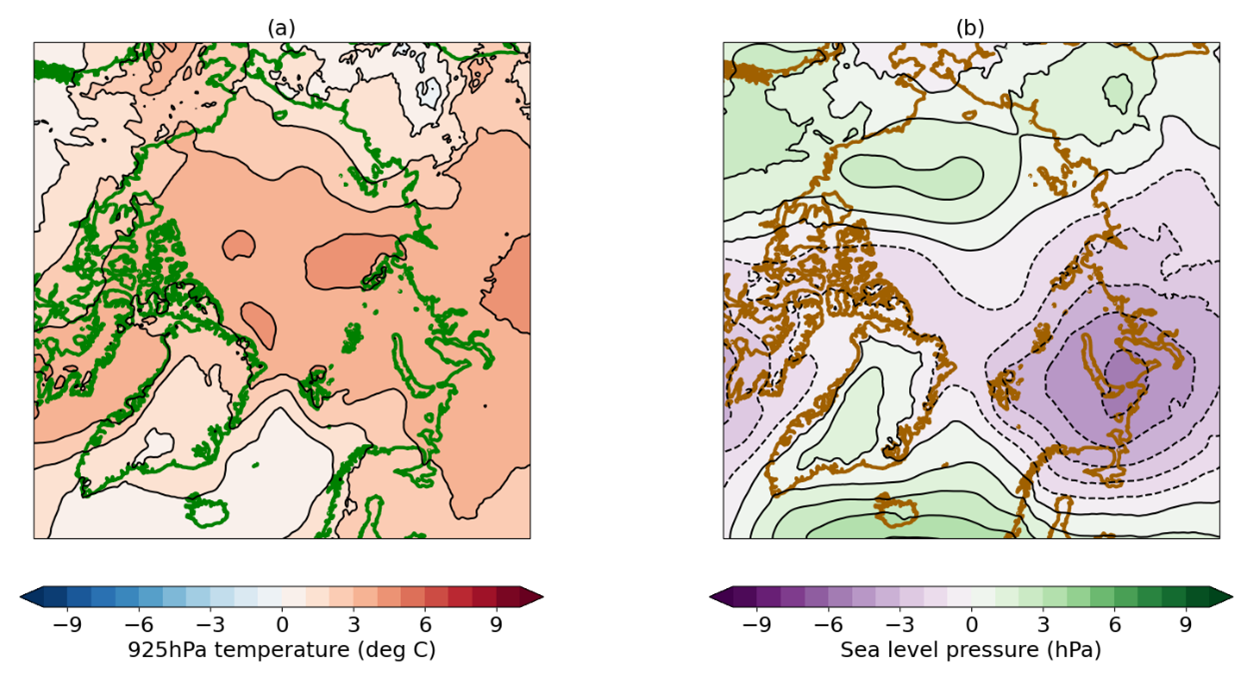
Figure 4. Anomaly in (a) 925hPa temperature; (b) mean sea level pressure for November 2024-March 2025 relative to the 1981-2010 average. Data are from the ERA5 reanalysis.
In association with the very mild temperatures, winter sea ice extent was comparatively very low. The maximum sea ice extent of 14.42 million sq km, recorded on 19th March, was by a small measure the lowest in the satellite record, the next lowest having been 14.48 in 2017 and 2018. The average sea ice extent from January 1st – March 31st was also the lowest on record at 13.68 million sq km.
Since 2011, a continuous record of winter ice thickness has been derived from radar altimeter measurements from the satellite CryoSat-2. Surprisingly given the mild winter, CryoSat-2 suggests there are many areas where Arctic sea ice at the end of winter was actually thicker than the 2011-2024 average, particularly north of Greenland (Figure 5). However, there were many regions where ice thickness was estimated to be near- or below-average, including seas such as the Beaufort and East Siberian Sea which tend to be more vulnerable to melt than the region north of Greenland. This may be explained by anomalously high pressure over the Pacific sector of the Arctic and low pressure over the Atlantic sector (Figure 4b), causing winds to blow ice more strongly into the region north of Greenland and away from the Siberian coasts.
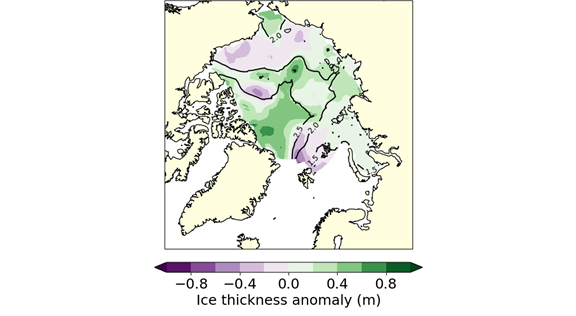
Figure 5. Sea ice thickness anomaly for March 2025 relative to the 2011-2024 average according to the CryoSat-2 radar altimeter observations. Contour lines of actual ice thickness are overlaid.
April saw settled weather in the Central Arctic with stormier weather towards the seas bordering the Atlantic Ocean; persistent southerly winds in between these regions caused further very mild temperatures, which continued into May.
Sea ice extent for May 2025 was 12.69 million sq km, 0.64 million sq km below the 1981-2010 mean (Figure 6). The rate of ice loss for the month averaged 56,000 sq km per day, the eighth fastest rate of loss on record for the month of May.
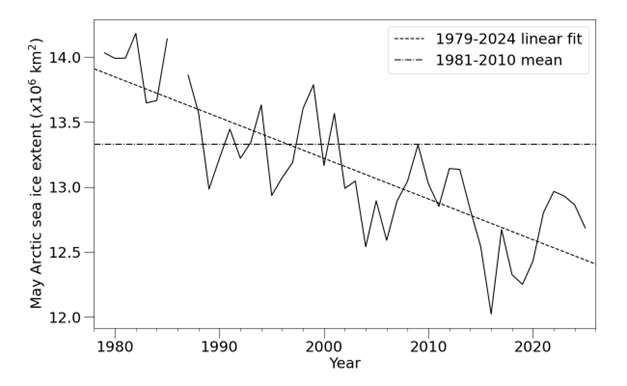
Figure 6. Average May Arctic sea ice extent according to the OSI SAF Sea Ice Index with 1979-2024 linear fit and 1981-2010 mean indicated.
Outlook for September
There is no significant correlation between ice extent in early June and the seasonal minimum extent in September, as the severity of melt is heavily dependent on Arctic weather conditions over the summer. Statistical predictions based on daily ice extent only start to achieve some skill by mid-July. Hence it is not possible to predict September sea ice extent with any confidence at this point in the season. It is likely that the mild weather conditions of the winter and spring will have rendered the sea ice more vulnerable to melt, but this effect could still be negated should summer weather be unusually cool. Regardless, it is highly likely that September sea ice extent will fall within the post-2007 range (3.6 to 5.1 million sq km), which is much lower than the 1981-2010 average of 6.76 million sq km.
Antarctic
Sea ice state
Antarctic sea ice extent on 8th June 2025 was 11.65 million sq km according to the OSI SAF Sea Ice Index. This was the 3rd lowest extent on record for the time of year, the lowest having been 10.92 million sq km in 2023. It was 1.32 million sq km below the 1981-2010 average (Figure 7).
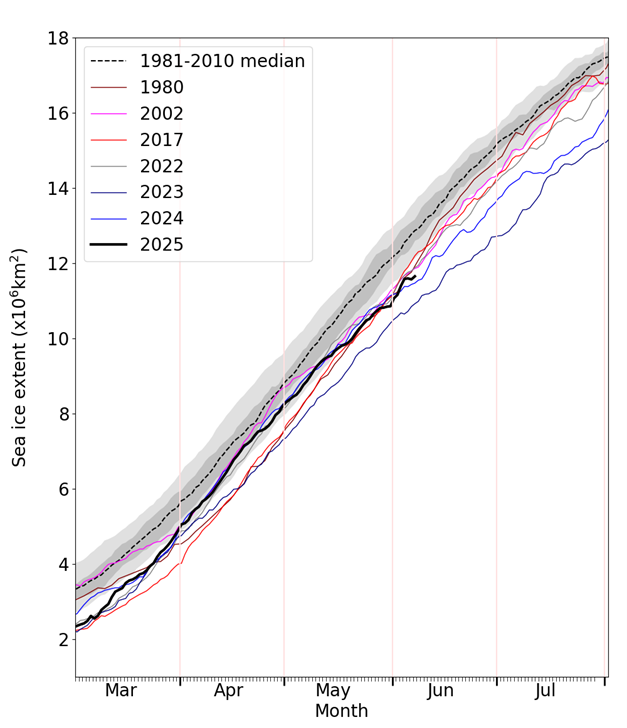
Figure 7. Daily Antarctic sea ice extent for 2025, compared with recent years and the low ice years of 1980, 2002 and 2017. Also shown is the 1981-2010 average with interquartile and interdecile ranges indicated by the shaded areas. Data are from the OSI SAF Sea Ice Index.
The low extent was not spread evenly around the Southern Ocean (Figure 8). Three regions of exceptionally low extent - the Bellingshausen Sea, the King Haakon VII Sea and to a lesser extent the Ross Sea – alternated with three areas of near-average extent, the Weddell Sea, Amundsen Sea and Indian Ocean sector.
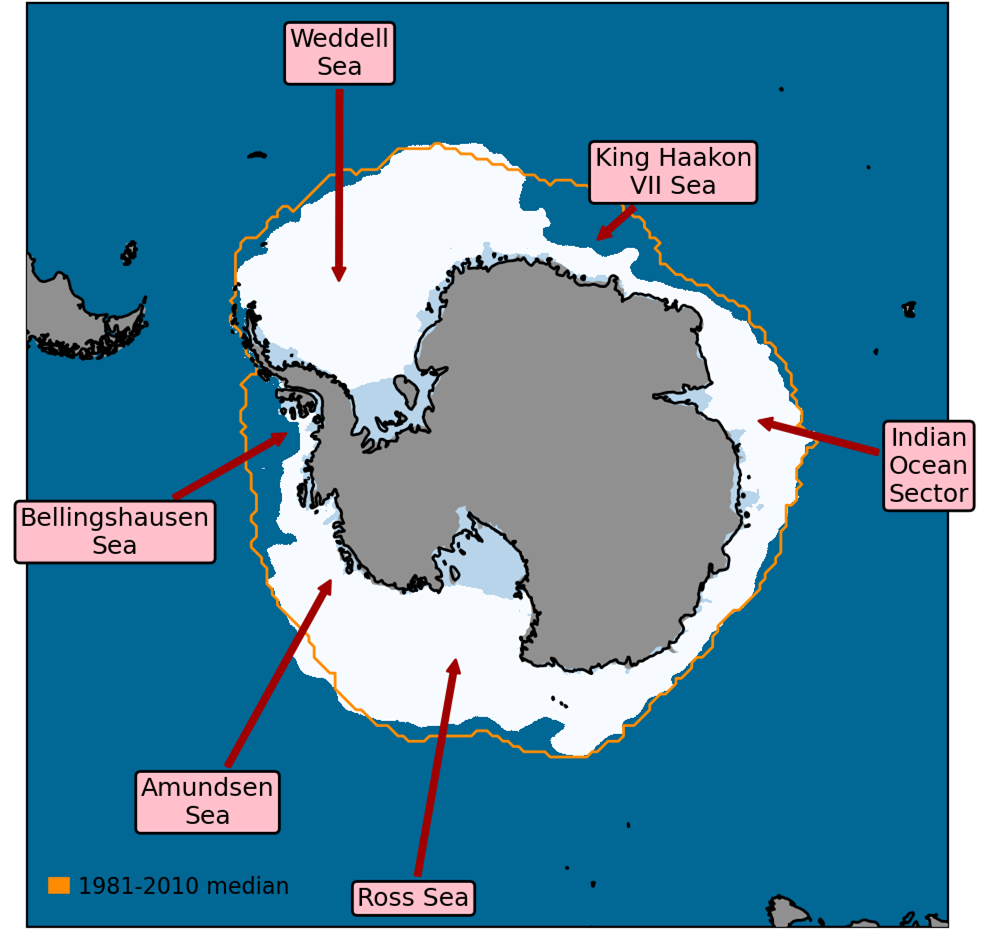
Figure 8. Antarctic sea ice extent on 8th June 2025, with 1981-2010 average extent indicated in orange, and with regions referred to in the text labelled. Data are from EUMETSAT OSI SAF (Tonboe et al., 2017).
Conditions in context
Antarctic weather patterns since early April have been characterised by a zonal 3-wave pattern that has been very common over the past few years (Schroeter et al., 2023), and was implicated in the very low ice extent of 2023, with three low pressure areas alternating with three high pressure areas (Figure 9). In the Southern Hemisphere, winds blow with high pressure to their left, hence warm northerly winds were prevalent over the areas with well-below average extent, while cold southerly winds coincided with areas of near-average extent.
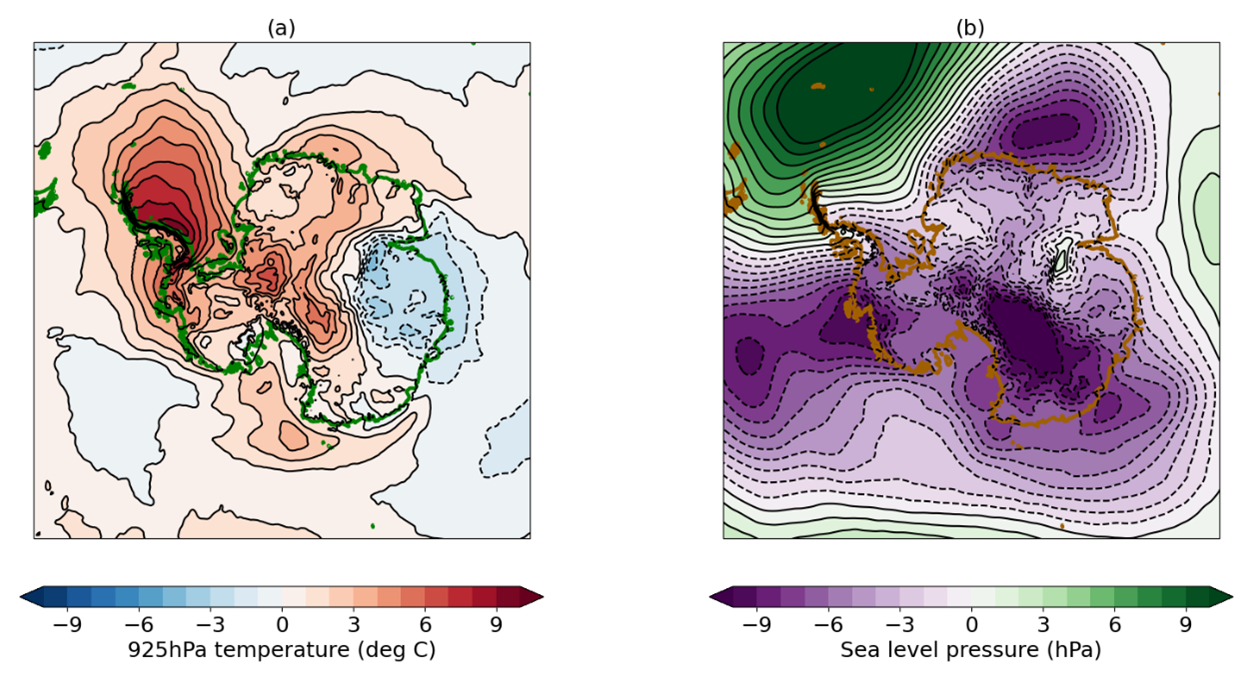
Figure 9. Anomalies in (a) 925hPa temperature; (b) mean sea level pressure for 1st April – 13th May, relative to the 1981-2010 average. Data are from the ERA5 reanalysis.
References
Hersbach, H. et al. (2017) Complete ERA5 from 1940: Fifth generation of ECMWF atmospheric reanalyses of the global climate. Copernicus Climate Change Service (C3S) Data Store (CDS). https://doi.org/10.24381/cds.143582cf. Date Accessed: 11-06-2025.
Lavergne, T. et al. (2023) OSI SAF Sea ice index 1978-onwards, Product OSI-420, Version 2.2, May 2023, Available at: https://thredds.met.no/thredds/osisaf/osisaf_seaiceindex.html
Schroeter, S., T.J. O'Kane and P.A. Sandery (2023) Antarctic sea ice regime shift associated with decreasing zonal symmetry in the Southern Annular Mode. The Cryosphere, 17, 701-717. https://doi.org/10.5194/tc-17-701-2023
Tilling, R.L., A. Ridout and A. Shepherd (2018) Estimating Arctic sea ice thickness and volume using CryoSat-2 radar altimeter data. Adv. Space Res., 62, 1203-1225. https://doi.org/10.1016/j.asr.2017.10.051
Tonboe, R., J. Lavelle, R.-H. Pfeiffer and E. Howe (2017) OSI SAF Global Sea Ice Concentration, Product OSI-401-b, Version 1.6, September 2017. Available at: https://osi-saf.eumetsat.int/products/osi-401-b


